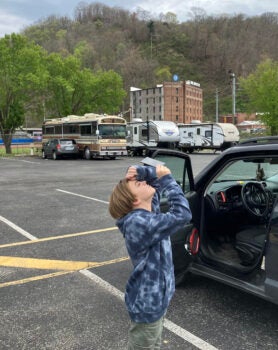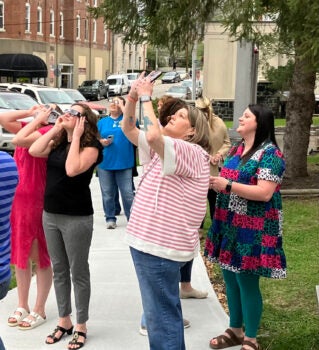Partial eclipse brings out sightseers
Published 11:23 am Wednesday, April 10, 2024
|
Getting your Trinity Audio player ready...
|
A large segment of North America found itself in the path of a total solar eclipse on Monday, April, 8, while adjacent areas not in the direct path such as Harlan could view a partial eclipse. Folks all over Harlan County stepped outside to have a look at the rare astronomical event.
The partial eclipse, according to the website Time and Date at https://www.timeanddate.com, began at 1:54 p.m., peaked at 3:09 p.m. and ended at 4:24 p.m. on Monday, April, 8.
Although clouds covered the sun for a most of the event, the sight did become visible occasionally offering onlookers the opportunity to view the eclipse through a variety of lenses, shades, and even a few homemade devices designed to avoid the severe eye damaging intensity of looking straight into the sun. Looking directly at the sun is not advised under any circumstances.
The rare event brought many people out to observe throughout Harlan County. The parking lot of the Harlan Center in downtown Harlan was a prime spot for observers to gather.
11-year-old Mason Raleigh, along with his mother, were among the observers utilizing the Harlan Center parking lot. Raleigh had also observed a partial eclipse which occurred in 2017, although that eclipse saw a smaller percentage of the sun hidden behind the moon.
Mason expressed his opinion of this eclipse with a thumbs up and one word: “Cool!”
The grounds around the Harlan County Courthouse also saw several groups taking the opportunity to view the event including staff from the various offices inside the courthouse, school children, and workers from the various businesses in the immediate vicinity.
A total eclipse could only be viewed in the most western parts of Kentucky such as Paducah.
According to the website Space.com at https://www.space.com, the next total solar eclipse visible in the continental United States will not occur until 2044. However, there will be a total solar eclipse visible from Alaska in 2033.








